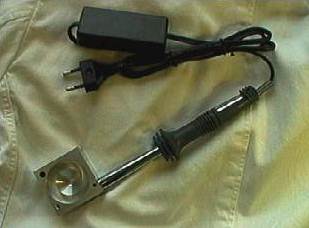Information on Microscale Experiments in the Netherlands
![]() Nederlandse versie van deze pagina
Nederlandse versie van deze pagina
These microscale experiments are becoming increasingly popular in the student labs. Teachers are developing their own microscale experiments and manufacturers are introducing new microscale glassware.
The Government and the Chemical Industry are financially supporting this national project. Sets consisting of microscale glassware and student booklets are offered to the schools at a reasonable price. The educational material is consistent with the leading textbooks. The material enables students to carry out organic chemistry experiments on their own in a safe and clean way. Also, teachers and their lab assistants receive ongoing training in the use of microscale experiments
Note that water-cooling is not necessary: faucets, hoses and drainage
are therefore no longer necessary. The glassware itself is highly durable
as it is relatively thick and light. Years of use in university labs have
proven this durability. It is the quality as the Borosilicate glass used
in larger chemistry glassware.
Microscale glassware comes in a small kit. A sand bath which we especially developed for this purpose accompanies the set. This heating method is low cost, safe and fast. A wall plug is the only prerequisite to work with the experiments: a fume cupboard is hardly ever necessary.

Click this picture for an article
on the heating device (in Dutch)
A digital multi-meter with thermocouple will possible become the newest addition to the set. The set currently comes with a large mercury-free thermometer. Large, because it needs to have a large range (-10 °C - + 250 °C) as well as be easily read. As a consequence, it doesn't fit the set to scale. The digital multimeter might be a good alternative. We are currently testing it. While the price is already very favorable, we obtained a discount for our project members. Meanwhile, we continue to supply the mercury-free thermometers with the sets.
The microscale experiments match the two most widely used Dutch textbooks (Chemie and Chemie Overal); however, instead of demonstration experiments, student lab experiments are described. When no experiments are described in the texts, suggestions are made. The choice of experiments is also based on these two books. However, suggestions when and where to apply the experiments are also made for those who use different textbooks. New experiments will continuously be developed.
As organic chemistry experiments are not very popular, the concerning chapters only contain a few experiments for the students. This is why we started with this type of experiment. However, we certainly will not be limited to them. Inorganic, analytical and physical chemistry microscale experiments can also be done with the glassware. When developing new experiments we incorporate as much as possible the demands of the users. The teaching material thus provides the teacher with a larger repertoire of experiments. Finally, the educational publishers have also expressed a great interest in microscale experiments; we expect that in their new editions they will incorporate these experiments.
The first version of the teaching material contains some basic techniques
as well as experiments like: Saturated and unsaturated hydrocarbons - Differentiation
of isomers: alcohol and ethers - Differentiation of isomeric alcohol's
- Esters: fragrances and taste.
We are currently developing new experiments. Among others, these involve the isolation of natural products and the synthesis of dyes. They will be distributed to all project members. The experiments are stand-alone but can also be a part of a larger project incorporated in the profile paper. As profile papers need to involve at least two school-subjects, we are developing experiments which also have a biological aspect. This could be the hydrolysis of protein, preparation and testing of a sunscreen lotion or a biotechnology feature.
The instruction of teachers and their lab assistants will be held regionally as much as possible and will take half a day. However, the membership encompasses more: members will receive new additions to the teaching material. Next to this, a web site has been developed. Here, members can exchange experiences and read the latest news.
Thanks to the subsidies of the government (the ministries of economic affairs, education and environment) and the financial support of the industry (The Dutch Chemical Association), it has been possible to supply the sets at a low price through the beginning of 1998.
If the purchase of the necessary sets (one set per two students) still presents too high a burden on the school's budget, the University of Amsterdam offers the possibility to spread payments over three years against a low interest rate.
See the prijslijst for details.
Stichting MicroC3hem
Nieuwe Achtergracht 129
1018 WS Amsterdam
Phone: **3120-5256583
Fax: **3120-5256586
E-mail: micro@chem.uva.nl